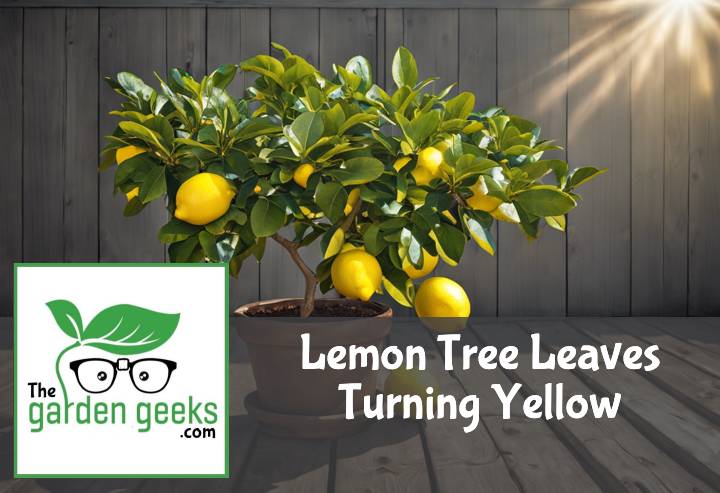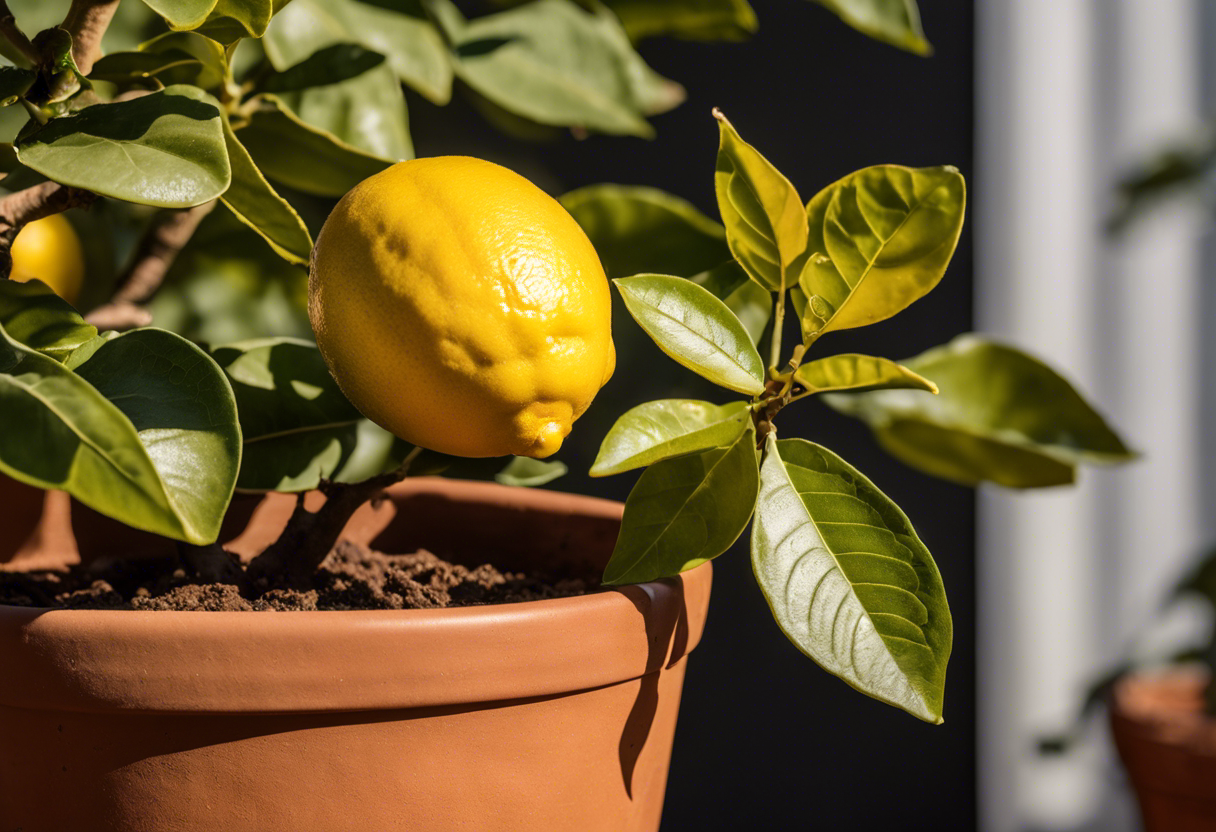Ever been strolling in your garden, coffee in hand, only to stop mid-sip because you spot your Lemon Tree Leaves Turning Yellow? Cue the panic. But hold on a sec! Before you start contemplating lemon tree funerals, let me assure you that this is not necessarily a death sentence for your citrusy friend.
Yellow leaves can be a sign of several issues but fear not, they’re often fixable. So put down that coffee (or maybe not, we might need it), roll up those sleeves and get ready to play detective. Keep reading about Lemon Tree Leaves Turning Yellow? (How to Save it)
Key Takeaways
- Yellowing leaves on a lemon tree can be due to overwatering, nutrient deficiencies, or disease.
- Overwatering can cause root rot, leading to yellow leaves. Ensure proper drainage and water only when the top inch of soil is dry.
- Nutrient deficiencies, particularly nitrogen, iron, and magnesium can cause yellowing. Use a citrus-specific fertilizer to correct this.
- Diseases like citrus greening or fungal infections can also cause yellow leaves. Consult a professional for diagnosis and treatment if you suspect disease.
Understanding Why Lemon Tree Leaves Turn Yellow
When it comes to lemon tree care, one common issue that might have you scratching your head is yellowing leaves. You see, leaf discoloration isn’t always a sign of the apocalypse for your citrus buddy. Sometimes, it’s just part of the natural process.
The Role of Chlorophyll in Leaf Coloration
Ever wondered why leaves are green? Well, thank chlorophyll for that! This pigment plays a crucial role in the photosynthesis process, giving leaves their vibrant green color. But when there’s a chlorophyll deficiency, things start to look a little yellow around the edges.
In other words, if you’re seeing green leaves turning yellow, it could be due to less chlorophyll production. It’s like your lemon tree is running low on its favorite green paint!
Common Causes of Yellowing Leaves in Lemon Trees
Now let’s talk about what causes this chlorophyll shortage. One big culprit is nutrient deficiency. Just like us humans need our vitamins and minerals, lemon trees need certain nutrients to stay healthy.
Overwatering your lemon trees can also lead to yellow leaves. Too much love (and water) can actually drown the roots and cause leaf discoloration.
Disease in lemon trees or pest infestation are other common reasons for those pesky yellow leaves. And don’t forget environmental stressors! Extreme temperatures or lack of sunlight can also make your lemon tree feel under the weather and result in those dreaded yellow leaves.
Identifying Specific Issues Causing Yellow Leaves
When your Lemon Tree Leaves Turning Yellow, it’s a cry for help. It’s like the tree is saying, “Hey, I’ve got some issues here!” But what could these issues be? Well, they usually boil down to three main culprits: nutrient deficiencies, watering problems, and pests or diseases.
Nutrient Deficiencies and Their Symptoms
Nutrient deficiencies are one of the most common lemon tree problems that can cause those vibrant green leaves to turn yellow. When your lemon tree isn’t getting enough of certain nutrients – like nitrogen, zinc or iron – its leaves can start to lose their green color.
These symptoms of nutrient deficiency often show up as yellowing leaves with green veins – a condition known as chlorosis. If you notice this happening on your lemon tree, it might be time to give it a good feed!
Overwatering or Underwatering: Signs and Effects
Another common cause of yellow leaves in lemon trees is improper watering. Both overwatering and underwatering can stress out your tree and lead to yellowing leaves.
Overwatered trees often have wilted or mushy leaves that turn yellow because the roots are drowning and can’t take up nutrients properly. On the flip side, underwatered trees may have dry, brittle leaves that turn yellow because they’re dehydrated.
So remember folks, when it comes to watering your lemon tree – not too much, not too little! Just right!
Pests and Diseases that Cause Yellow Leaves
Last but not least on our list of suspects are pests and diseases. Certain bugs love munching on citrus leaves – aphids, mites, scale insects – you name it! And when they do their dirty work, they can leave behind a trail of yellow leaves in citrus trees.
Diseases too, like citrus canker or greasy spot, can cause those lovely green leaves to turn yellow. So if you see any suspicious spots or bumps on your lemon tree’s leaves, it might be time to call in the plant doctor!
How to Save Your Lemon Tree with Yellow Leaves
Oh, dear! Is your lemon tree leaves turning yellow? Don’t fret. There are common reasons for this, and they’re usually tied to nutrient deficiencies, watering practices, or pesky pests/diseases. But hey, we’ve got some solutions up our sleeves that’ll have your lemon tree care game on point in no time.
Correcting Nutrient Deficiencies
So you’ve noticed yellow leaves on citrus trees, huh? One culprit could be nutrient deficiencies. These sneaky little devils can turn your green thumb into a yellow one real quick.
But how do you spot them? Well, if your lemon tree is looking more like a banana tree (you know, all yellow and stuff), it might be lacking some essential nutrients. Iron or nitrogen deficiency in lemon trees is often the main offender here.
Don’t worry though; there’s a fix! You can use specific citrus fertilizers or soil amendments for lemon trees to replenish those missing nutrients. It’s like giving your tree a well-deserved spa day!
Adjusting Watering Practices for Healthier Trees
Another reason for your lemon tree leaves turning yellow could be improper watering. Yes, believe it or not, there’s an art to watering lemon trees.
Overwatering citrus trees can drown their roots while underwatering can leave them parched and thirsty. It’s all about finding that Goldilocks zone of just right.
So what are the healthy watering habits for lemon trees? Well, it’s simple: water deeply but infrequently. This encourages the roots to grow deeper and stronger. Remember the phrase “less is more” when it comes to citrus tree irrigation practices.
Treating Pests and Diseases
Last but not least, let’s talk about pests and diseases – every gardener’s worst nightmare. These uninvited guests can cause havoc, leading to yellow leaves on citrus trees.
Common pests in lemon trees include aphids, scale insects, and the dreaded citrus leaf miner. As for diseases, watch out for things like root rot or fungal infections.
But don’t panic! Treating a diseased lemon tree is doable. There are plenty of treatments available that can help you fight off these invaders and prevent citrus disease spread. So roll up your sleeves and get ready to save your ailing lemon tree!
Preventive Measures to Avoid Yellow Leaves
When it comes to lemon tree care, an ounce of prevention is worth a pound of cure. Let’s dive into the preventive measures that can keep your lemon tree from turning into a yellow-leafed sad sap.
Proper Fertilization Techniques for Lemon Trees
The first step in preventing yellow leaves is proper fertilization. Lemon trees are like teenagers, they’ve got specific dietary needs. Using a balanced citrus fertilizer can help maintain the vibrant green color of the leaves.
Now, you might be wondering what kind of fertilizer is best for lemon trees? Well, they prefer something high in nitrogen and low in phosphorus. This combo helps them grow strong and healthy without causing any leaf discoloration.
Remember, over-fertilizing can be just as harmful as under-fertilizing. So, stick to the recommended dosage on the package and your lemon tree will thank you!
Ideal Watering Practices for Lemon Trees
Next up on our list of yellow leaves prevention techniques is watering practices. Just like Goldilocks, lemon trees don’t like their water too hot or too cold – they want it just right!
Overwatering or underwatering can stress out your tree leading to those dreaded yellow leaves. The trick here is consistency. Keep the soil moist but not soggy.
If you’re unsure whether your tree needs water, poke your finger about an inch into the soil near the base of the tree. If it feels dry, it’s time to water. If it’s damp, hold off for another day or so.
Regular Pest and Disease Inspection
Last but certainly not least in our trifecta of lemon tree care is regular pest and disease inspection. Pests and diseases are sneaky little devils that can cause havoc on your precious lemon tree.
Regular inspections can help catch these issues early before they lead to leaf yellowing. Look out for signs of pests like aphids, scale insects, and citrus leaf miners.
Also, keep an eye out for diseases such as citrus canker or greasy spot. If you notice anything unusual, take action immediately! Your lemon tree’s life may depend on it.
To Wrap Up
Like a toddler with a new toy, your lemon tree can throw a fit—Lemon Tree Leaves Turning Yellow—when it’s not happy with its environment. But fear not, you’re now armed with all the knowledge to save it!
So, don your gardening gloves, and let’s turn those yellow leaves green again! Remember, a little love goes a long way in the plant world.





